Is ConstructConnect worth it? ConstructConnect promises to make life easier for general contractors, subcontractors, and suppliers by streamlining the preconstruction process. With impressive numbers – 1.4 million active projects, over $3 million spent on documents, and coverage in 400+ metropolitan areas – it’s easy to see why it’s so popular.
But big numbers don’t always mean big value. To truly assess whether the platform is worth your time and investment, you need to look beneath the surface. Does it provide the bid coverage you need? How reliable is the subcontractor database? What kind of return can you expect as a general contractor? And just as important – what doesn’t it get right? Read on to find out.
Note: Downtobid drastically reduces the time you spend analyzing complex construction plans by automatically identifying scopes within your project, allowing you to create more accurate estimates. It then recommends ideal subcontractors for each part of the job and creates personalized ITBs, meaning you can start building meaningful relationships with subs right from the beginning. Sign up for a demo today (for free) and experience the difference Downtobid can make for your preconstruction process.
Key Takeaways
- ConstructConnect has 100,000+ bidders but outdated self-updated profiles with missing contacts, inconsistent trade mapping.
- Platform uses mass ITB "spray and pray" at $3,600+ annually with opaque pricing, complex prequalification.
- Downtobid provides AI verification, direct email confirmation, regular follow-ups for accurate data.
- Personalized ITBs achieve 30% higher responses with scope summaries, compelling subjects, strategic follow-ups.
- Downtobid offers transparent pricing, rapid deployment, bid transparency, eliminates surprises.
ConstructConnect: The Quick Verdict
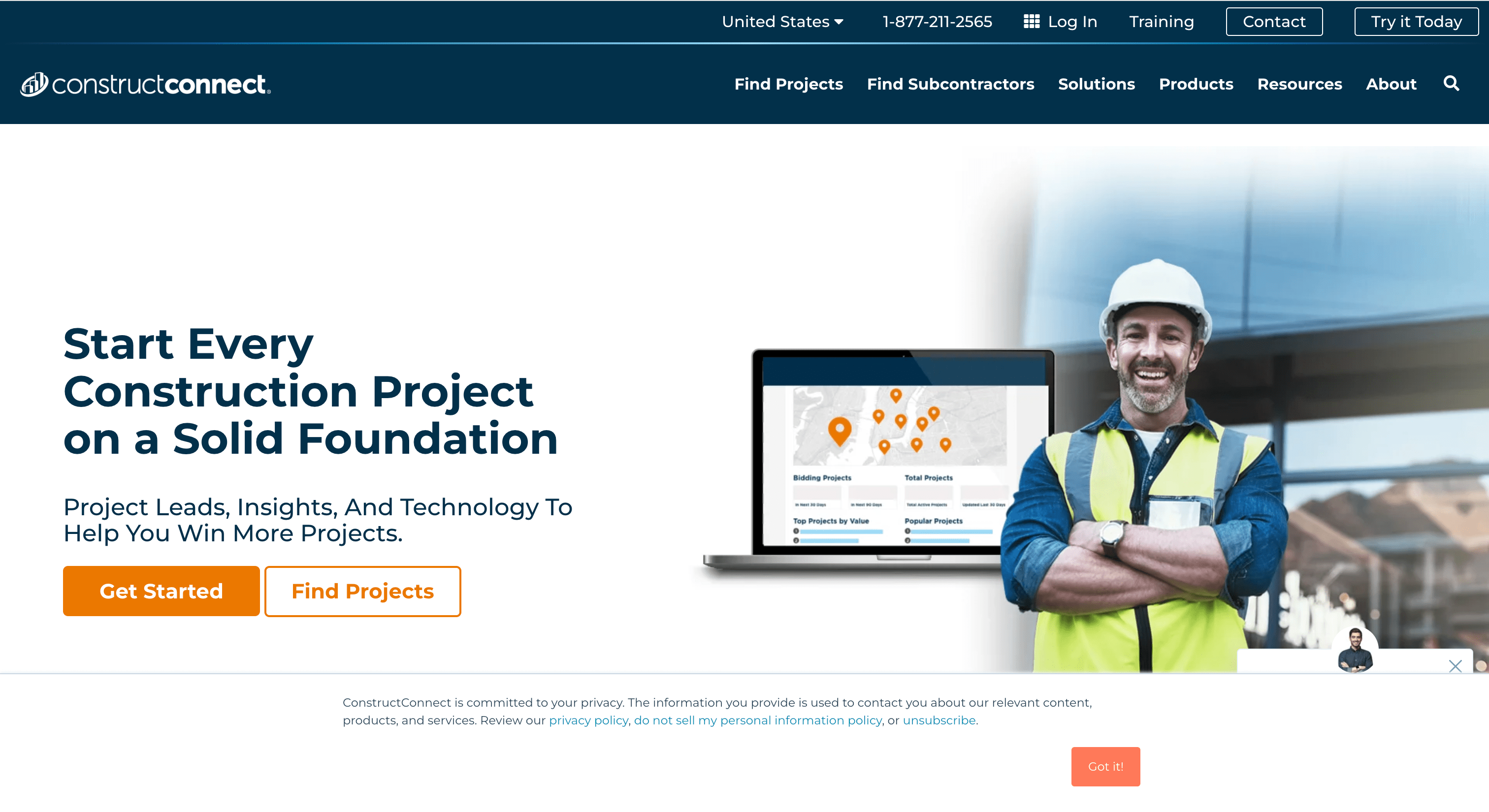
Pros:
- Largest subcontractor network (100,000+ bidders nationwide)
- Extensive project database (1.4M active projects)
- Prequalification module with custom forms
- Bid-day management tools
Cons:
- Outdated, self-maintained subcontractor profiles
- Generic "spray and pray" ITB approach yields low response rates
- $3,600+ annual cost with opaque pricing for advanced tiers
- Complex prequalification process (G2 reviews cite inflexibility)
- Poor data quality (missing contacts, inconsistent trade mapping)
Subcontractor Network
One of ConstructConnect’s biggest selling points is its extensive subcontractor database. The platform boasts the largest network of construction professionals (100,000 bidders nationwide), thanks in part to its acquisitions of iSqFt and SmartBid.
The idea is simple: the more options you have access to, the easier it is to find the perfect subcontractor fit for your projects. Whether you're expanding into new territories or your usual team is stretched thin, having a massive database means you can search and reach out to more potential partners, grow your network, and ultimately scale your business.
But this large database also introduces a critical issue: data quality. The platform relies on subcontractors to keep their information updated, and that's not always a priority for most contractors. As a result, here’s what you might run into:
- Trades aren't consistently mapped to CSI Codes, making it difficult to quickly identify appropriate project leads for specific job requirements.
- Contact details are missing or flat-out wrong.
- Key information like union status, MWBE certifications, or the types of projects they’ve worked on is absent.
- Subcontractors may be listed for regions they no longer serve, leading to mismatched project opportunities.
- Retired employees might still be listed, making it even harder to get ahold of the right person.
The promise of finding new, capable subcontractors is appealing, but the reality of sifting through potentially outdated or inaccurate information can be time-consuming and frustrating.
On TrustRadius, users specifically complain that ConstructConnect's cloud-based software is "completely unreliable" and that when signing in, they never know if the system will work as intended. Several users note that the system "never seems to be functioning at 100%" and frequently experiences problems, especially around data updates, feeling that ConstructConnect does "a poor job updating information
In contrast, let’s compare that to what a platform like Downtobid offers when it comes to making sure you’re working with the right subcontractors (and getting accurate information.) The platform prioritizes quality over quantity, using a multi-tiered verification process that blends AI with proactive checks, so you can trust the data you’re working with.
Here’s how we make sure you get up-to-date, relevant information:
- We use AI to accurately categorize the trades each subcontractor lists on their website, ensuring that they’re matched to the right project type.
- If the subcontractor has a portfolio page, we analyze it to infer their preferences in project size, project scope, and types, so you’re not left guessing.
- Before adding subcontractors to our database, we email them directly to confirm the contact information and make sure their companies are still operational.
- We pull from various sources – including Google Maps and local trade associations – to confirm the subcontractor’s current service areas.
- We follow up after every response and update the subcontractor’s email and contact information, keeping everything fresh and accurate.
For a deeper dive into how we accomplish this, you can read more here.
To see how our subcontractor network looks in practice, here’s an example sublist directory: https://downtobid.com/contractors/hvac/dallas

And here’s an example profile: https://downtobid.com/company/airpro-mechanical

While ConstructConnect offers a large network, it lacks robust data validation, leading to outdated contacts and unreliable info. Downtobid’s multi-step verification ensures every connection is current and actionable, saving you time and delivering more trustworthy project leads.
Subcontractor Prequalification
To avoid the risks of safety issues, schedule delays, or even subcontractor defaults, prequalifying your subcontractors before inviting them to bid is key. ConstructConnect addresses this need with its prequalification module, allowing you to collect and review essential information from potential subs. The module lets you use industry-standard forms or create custom ones, making it easier to vet subcontractors based on their safety records, performance history, and financial stability.
On paper, this sounds great — you get to choose subs based on their qualifications, experience, and ability to get the job done. But like anything, there are some limitations:
You might unintentionally leave out capable contractors who don’t meet specific prequalification criteria, which could limit competition and your pool of options.
Managing and maintaining all those prequalification forms can turn into a huge administrative hassle, both for you and the subs.
Based on G2 reviews, contractors hate this platform. One verified user gave a 1-star review, slamming the software for being inflexible with zero ability to customize databases for their workflows.
Bid Coverage
Adequate bid coverage helps you in a few key ways:
- You can assess a project’s feasibility more accurately.
- It makes resource allocation – different labor costs, materials, and equipment – easier to manage.
- More bids from multiple subs boost competition, which can lead to better pricing and terms, ultimately improving your project’s cost and profitability.
Plus, when your bids come from a diverse pool of qualified subcontractors, you reduce the risks of project delays, quality issues, or even financial instability. In short, the more qualified bids you have, the smoother your project is likely to go.
Now, in an ideal world, you’d always have perfect bid coverage. Unfortunately, there are too many variables in play – project location, type of work, the subcontractor’s availability, and more – that impact a sub’s decision to bid.
But there’s a strategy that can help you improve your bid coverage: optimizing your ITBs. By identifying what influences a sub to bid (whether it’s the project size, scope, or other details) and communicating those factors clearly upfront, you make your invitations more attractive and more likely to get a response.
Automated Bid Invitations
We conducted research into public and private data, analyzing population metrics, market spend, 60,000 historical subcontractor bids, and a national subcontractor database to uncover what really drives subcontractors to bid. Our findings point to a few key factors:
- GC brand: Subs prefer to work with well-known GCs, especially ones they’ve worked with before.
- Distance: Jobs within 55 miles of the subcontractor’s location get more attention. Anything over 150 miles starts to become less attractive.
- Scope of work: If the job fits a sub’s preferred work, they’re much more likely to respond.
At first glance, these factors seem pretty set in stone – after all, you can’t build a reputation overnight. But what you can control is how you communicate through your ITBs.
So, how does ConstructConnect handle this critical step?
The platform makes it quick and easy for GCs to create, modify, and send ITBs to prequalified subs. You can automatically target subcontractors based on their location and capabilities.
The downside? ConstructConnect’s approach encourages a “spray and pray” mentality. GCs are encouraged to send out mass invites – sometimes thousands at a time – under the assumption that the more bids, the better. Miss one, and you risk losing the whole job.
Except, from the subcontractor’s side, it doesn’t work that way. They’re drowning in invites, and most of them are generic invitation templates which often end up in the same overwhelming pile. In fact, based on our study of nearly 600,000 emails, most ITBs subs receive get declined.
To tackle this, we ran an experiment comparing two types of ITBs:
- Templated ITBs: Standard, one-size-fits-all templates.
- Optimized ITBs: Customized invites, focusing on key factors like GC brand and job proximity.
The results? Optimized ITBs brought in way more responses and bids from subs. When you put the right information in front of subcontractors – details that matter, like who you are and how close the job is – you’re far more likely to get the responses you need.
You can check out the response rates from users who prioritized personalized invites for yourself below:
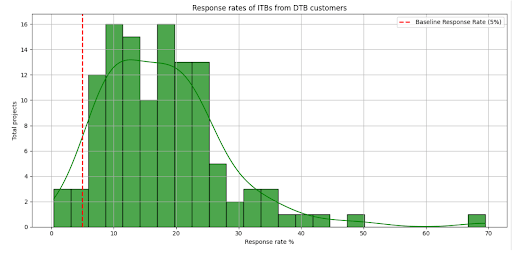
Our personalized approach to ITBs has yielded impressive results, with users experiencing an average 30% increase in responses from targeted subcontractors. Here's what makes our ITBs so effective, they:
- Clearly show why each subcontractor is perfect for the job, matching their skills and experience with your project’s needs.
- Offer all necessary project details upfront, including a clear scope of work, so subcontractors can easily determine if they’re the right fit without going through complex plans.
- Use compelling subject lines that feature key details like project size, type, and location to ensure your invites stand out and get opened.
- Send 2-3 follow-up messages at appropriate intervals to keep the opportunity top-of-mind and show your genuine interest in their participation.
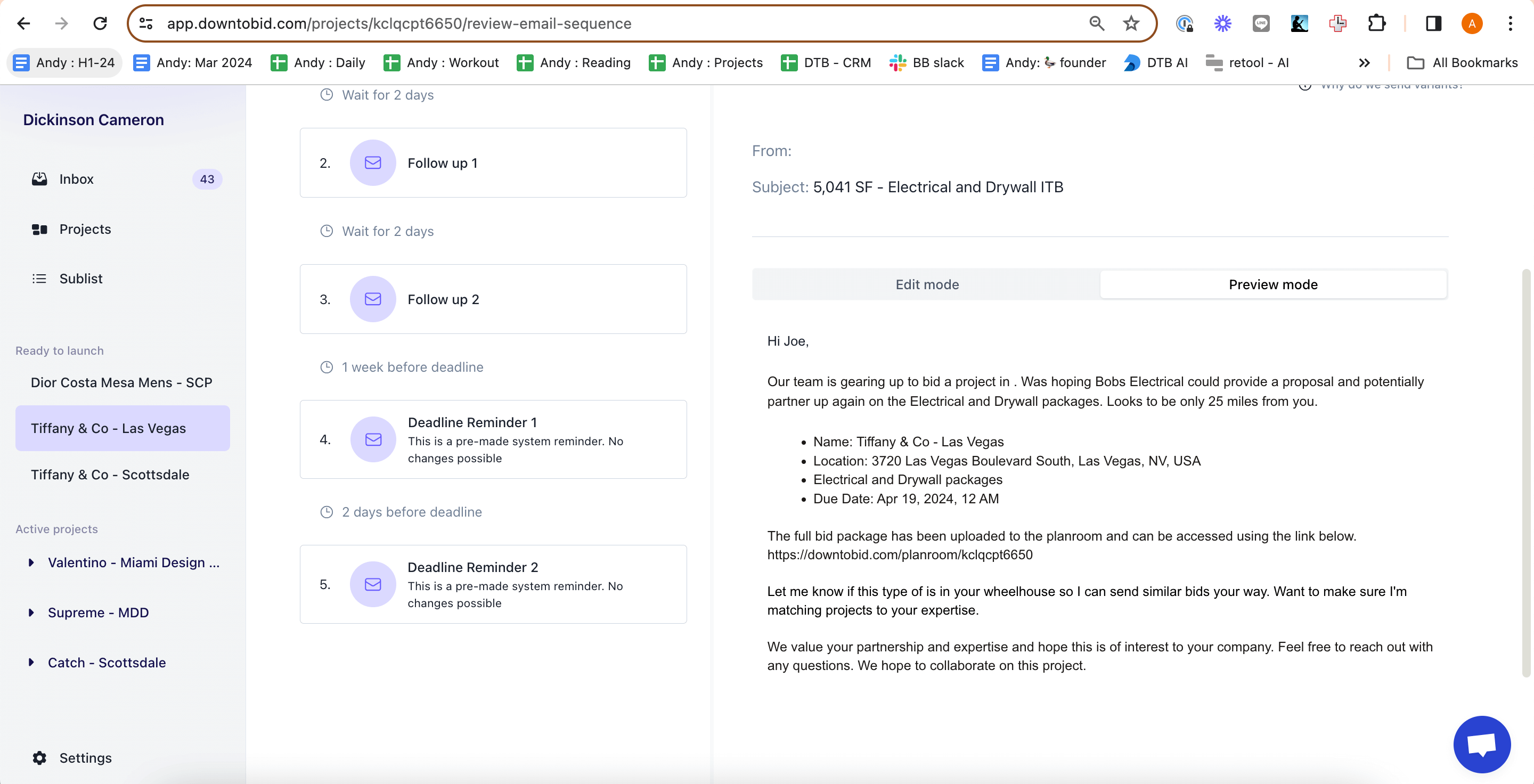
Taking this approach helps you build better relationships, improve the quality of bids you receive, and get better project outcomes overall. In fact, some of our users have reported over a 60% response rate and more than 80 bids for a single project.
Is ConstructConnect Worth It? (Pricing + A Better Alternative)
ConstructConnect’s Bid Management package starts at $3,600 per year, granting access to a nationwide subcontractor network, private directory contacts, communication templates, feedback reports, and bid-day tools. For more comprehensive solutions that bundle Bid Management with Project Intelligence or Digital Takeoff, you'll need to contact them directly for pricing.
At $3,600/year, that price tag can be a hard pill to swallow for many GCs, especially those who don’t need all the features included into the platform. Also, the lack of transparency in pricing for higher tiers means you're left in the dark about potential costs until you engage with their sales teams. You can learn more about ConstructConnect's software and plans here.
Downtobid, on the other hand, offers a more straightforward and cost-effective pricing structure Basic for up to 3 users and Pro plan for up to 10 users. No hidden fees or surprise costs – just simple, transparent pricing that makes it easier to budget and plan.
When you compare that with ConstructConnect’s tiered and somewhat opaque pricing, Downtobid provides a better and clear value for you money. You get all the essential tools without the extra layers of complexity or an expensive price tag, so you can focus on running your projects and improving your productivity, not worrying about your budget. Read a detailed comparison of Downtobid, ConstructConnect vs PlanHub here.
Tired of paying for features you never use? Many GCs find ConstructConnect and similar platforms filled with unnecessary complexity. Downtobid (DTB) takes a different approach, focusing on what matters most: clear coverage visibility, effective subcontractor engagement, and straightforward bid management—without the bloat.
What Makes Downtobid Different
- Total Bid Transparency: See exactly who's been invited and why. Each subcontractor receives tailored information highlighting the specific plan sheets relevant to their trade. You'll always know which trades are covered and which need attention, letting you intervene only when necessary.
- Streamlined Workflow: Downtobid's AI technology identifies required trades for each project and prepares customized invitations accordingly. Smart follow-up sequences maintain momentum without requiring your constant attention, allowing you to concentrate on critical decisions instead of repetitive administrative tasks.
- Rapid Deployment: Getting started is refreshingly simple. Upload your project documents and our system does the heavy lifting—automatically categorizing drawings and detecting scope elements. Most teams can send their first batch of targeted invitations within hours, not days or weeks.
Why GCs Make the Switch
- Eliminate Bid Day Surprises: Our dashboard clearly flags trades with insufficient coverage, giving you time to address gaps well before deadlines approach—reducing last-minute scrambles.
- Enhance Subcontractor Experience: By providing precisely what each trade needs to evaluate a project, we help subs make quick, confident decisions about participation. This means fewer clarification calls and more productive conversations.
- Grow Without Growing Pains: Our platform scales naturally with your business volume without introducing additional complexity. Whether managing five projects or fifty, the process remains consistent and manageable.
- Cultivate Reliable Partnerships: Subcontractors appreciate clear, relevant invitations. Over time, this straightforward approach helps develop a more responsive network of trusted trade partners who prioritize your projects.
It’s also incredibly simple to get started with Downtobid:
Getting Started with Downtobid
Sign up for a demo (PDF, up to 1GB) for free.
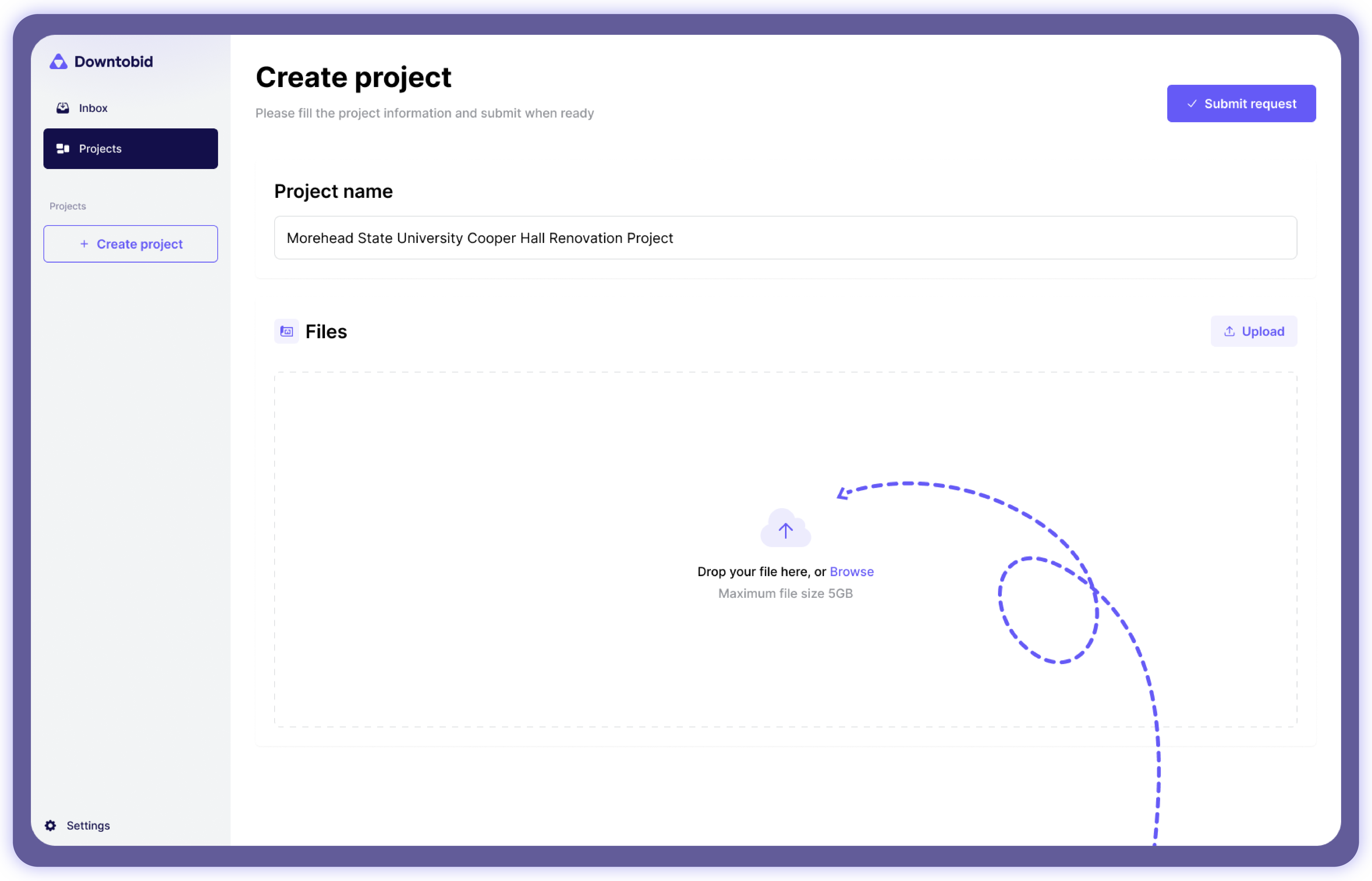
Enter your email and click "Create Project."
In 10–30 minutes, our AI will review your plans for scopes, identifying relevant project details, providing scope summaries, and suggesting local subs you can reach out to.

Log in to view your bid packages, including scope sheets and recommended subs in your dashboard.
The system automatically schedules ITBs to be sent at optimal times, with detailed scope summaries and follow-up emails.
Subcontractors can access your indexed Planroom – which includes construction plans, specs, and bid details – without an account, making it easy for them to review the project and decide if they’re a fit.
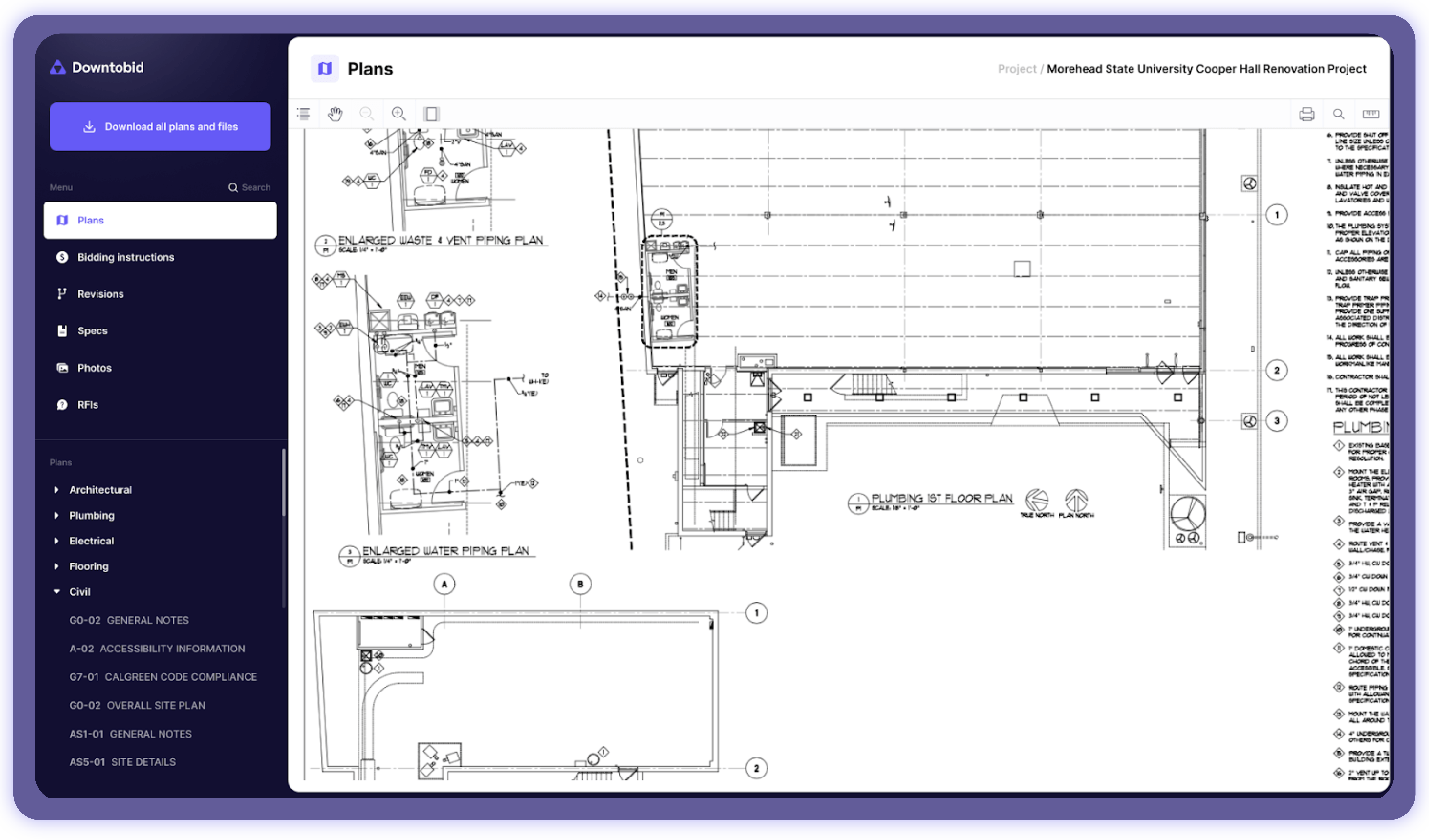
The best part? You can get started for free. Try a free demo today and see how Downtobid can streamline your bidding process.
FAQ: Is ConstructConnect Worth It?
Is ConstructConnect worth it for small GCs?
ConstructConnect is generally not ideal for small general contractors due to its relatively high cost, complex setup, and feature richness that suits larger companies better. Small GCs may find it too expensive and too complex for their needs compared to simpler platforms.
Is ConstructConnect worth it compared to PlanHub/BuildingConnected?
Compared to PlanHub and BuildingConnected, ConstructConnect tends to be more expensive with less transparent, quote-based pricing and additional costs for many essential features. PlanHub is more budget-friendly and straightforward, while BuildingConnected also offers extensive features but can be costly and less transparent. ConstructConnect offers extensive project data but at a higher total cost and complexity.
What are the hidden costs of ConstructConnect?
Hidden costs include fees for add-ons such as digital takeoff and estimating tools (PlanSwift, QuickBid), lead tracking, training, and advanced reporting. Many users report unpredictable pricing beyond the base subscription due to required tool bundles.
How long does ConstructConnect implementation take?
Implementation time varies depending on the tools selected and company size. However, onboarding and training on ConstructConnect are commonly reported to take longer than simpler platforms due to its breadth and complexity
Can I cancel ConstructConnect mid-contract?
ConstructConnect typically requires annual contracts with limited flexibility for mid-contract cancellation. Early termination may be difficult and could involve penalties or lost fees, so mid-term cancellation is generally not allowed or costly.